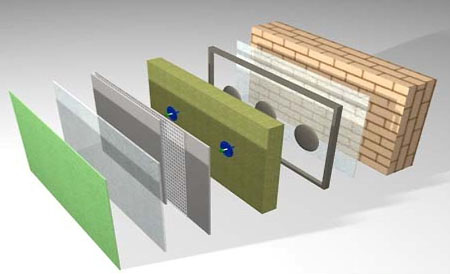Technology
What Is Plaster Facade?
The plaster facade is “a pie” consisting of slag-wool and/or expanded-plastic plates covered with a multilayered surface, which are applied in a definite order and with certain intervals to provide the durability of the system.
Functions of Ventilated Facade Systems
- Decorative: A variety of colors allows emphasizing the individual character of a building and provides wide choices for laboring its overall appearance.
- Protective: Not only the finishing covers are decorative and add an aesthetic look and feel to a building, but they also defend the frost-protection material from external adverse effects (ultra-violet radiation, atmospheric condensation), and are waterproof, vaporproof, and resistant to crackling and delaminating.
- Heat- and Energy-Saving: The heat-insulating material provides warming of enclosing structures. Its width is depends on thermotechnics calculations, while the type of material depends on fire-prevention requirements.
- Sound-Proof: Plaster facades increase sound-proof parameters of main walls ca. 1.5-2-fold and are capable to provide the internal silence in a building and, respectively, comfortable conditions for labor and recreation even in the noisiest areas. Facing Choices: Actually, the basic choice is the only one: namely mineral, organo-siloxane polymer or acryl plaster. At the same time, a huge variety of finishing covers and color layouts enables realizing any architect’s design. Combining a plaster facade with three-layer system of a ventilated facade to receive a shining mixture of plaster and stone is also possible.
Arrangement of a Plaster Facade: The slag-wool and/or expanded-plastic plate fastens to the basis by means of glue mixture and studs. This layer is followed by the reinforced layer consisting of glue mixture with glass-fiber-fabric lathing, and to top it all the “finishing” decorative plaster layer, primer coat and paint are applied.
Basic Advantages of System Plaster Facades
- Creating comfortable conditions in a building due to heat- and sound-insulation and providing the optimum humidity mode
- Aesthetic look and feel of a building
- Fire safety due to usage of high fire-resistant and fireproof materials and products Significant lowering the expenses for construction due to decreasing the building construction gross weight and reduction of volumes of excavating, concrete and other operations.
- Ability to install plaster facades on weak surfaces (sub-standard cellular concrete, Khrushchev’s 5-store buildings, old bricklaying, etc.) and on the surfaces having unnormalized deviations from plainness up to 500 mm. Facade alignment is provided by increasing the heater thickness, amount of glue and stud length.
- The price of plaster facade is by far cheaper as compared to other systems.
Structural Drawing
